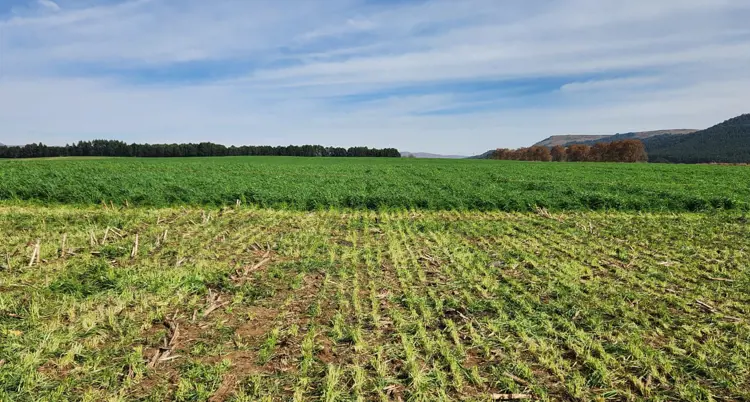Fodder Flow Planning for Dairy Farming in KwaZulu-Natal, South Africa
Dairy farming in KwaZulu-Natal (KZN) is a vital component of South Africa’s agricultural economy. The region benefits from a favourable climate, fertile soils, and relatively high annual rainfall, making it an ideal environment for pasture-based dairy operations. However, even with these natural advantages, dairy farmers must contend with seasonal changes in forage availability, variable rainfall patterns, and fluctuating input costs. These challenges make fodder flow planning essential to maintaining consistent milk production and economic stability throughout the year.

Fodder flow planning is the process of aligning the availability of feed resources with the nutritional needs of a dairy herd over twelve months. Without such planning, farmers may encounter feed shortages during critical periods, which can compromise milk yields, reduce animal health and fertility, and increase reliance on costly purchased feeds. Conversely, periods of excess feed availability can lead to wastage and poor forage utilisation. Therefore, a well-developed fodder flow plan is fundamental to optimising feed use, sustaining animal productivity, and improving farm profitability.
Seasonal Considerations in KwaZulu-Natal
The climate in KwaZulu-Natal is marked by a summer rainfall pattern, with most precipitation occurring between October and March. This season supports the growth of summer pastures, such as kikuyu, and is the primary period for silage and hay production. During this time, farmers can rely heavily on grazing, while also conserving excess forage as silage for use in the drier months. As the region transitions into autumn, pasture growth slows significantly, and the availability of green forage declines. This makes April and May a critical time to begin supplementing with conserved feed.
Winter, which spans from June to August, presents the greatest nutritional challenge for dairy farmers in KZN. Low temperatures and reduced rainfall limit pasture growth, necessitating a reliance on silage, hay, and concentrate feeds. Spring, from September onwards, marks the beginning of renewed pasture growth, but this growth is gradual and depends heavily on timely rains and soil fertility.
Understanding these seasonal patterns is crucial in estimating when and how much feed will be needed and in ensuring that conserved fodder is sufficient to meet the herd’s nutritional demands during the off-season.
Developing a Fodder Flow Plan
The foundation of an effective fodder flow plan begins with an accurate understanding of the herd’s nutritional requirements. This involves categorising animals by production stage, such as lactating cows, dry cows, heifers and calculating their daily and seasonal dry matter (DM) intake needs. With this baseline, the next step is to take a comprehensive inventory of the available feed resources, including current pastures, silage stocks, hay bales, and potential crop residues. Farmers should also estimate expected yields from upcoming forage crops based on historical data and current conditions.
Once feed availability and requirements are quantified, the farmer or consultant can construct a monthly or seasonal plan that maps out how and when each feed source will be utilised. This includes developing a grazing and cropping calendar that considers pasture rotations, planting and harvesting dates, and fertiliser applications. In KZN, ryegrass is often over sown into kikuyu bases to extend the grazing season into winter, while maize remains the dominant crop for silage due to its high yield and energy content. Oats or stooling rye is generally planted as a cover crop behind the maize, which then forms part of the grazing platform in winter.
Supplementation plays a critical role in bridging any nutritional gaps identified in the plan. When pastures and silage are insufficient in meeting the animals’ energy or protein needs, concentrates or byproducts can be introduced. These should be carefully formulated to maintain cost-effectiveness and avoid nutrient imbalances. Additionally, proper storage and preservation of silage and hay are essential. Ensuring airtight sealing, regular quality testing, and protection from weather exposure helps maintain feed quality and reduces spoilage.
Monitoring is a continuous component of fodder flow planning. Conditions such as weather variability, herd size changes, and forage quality fluctuations require farmers to be flexible and ready to adjust the plan as necessary. Keeping detailed records of feed stocks, forage yields, and animal intake allows for timely decision-making and improves planning accuracy in future seasons.
Conclusion
In KwaZulu-Natal, where climate and pasture growth are highly seasonal, fodder flow planning is not merely a management tool but a strategic necessity. The ability to consistently match feed supply with demand across all seasons is key to achieving stable milk production, optimal animal health, and financial sustainability. By investing time and resources into a thorough and adaptive fodder flow plan, dairy farmers can not only reduce costs and dependence on purchased feeds but also build resilience in the face of climatic and market uncertainties.
If you require any additional information regarding fodder flow planning on dairy farms or have further questions, please do not hesitate to contact your local technical advisor to ensure you are fully up to speed - www.deheus.co.za/meet-our-team
